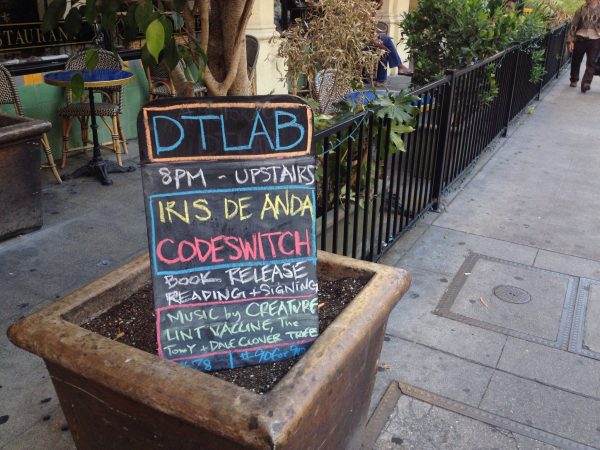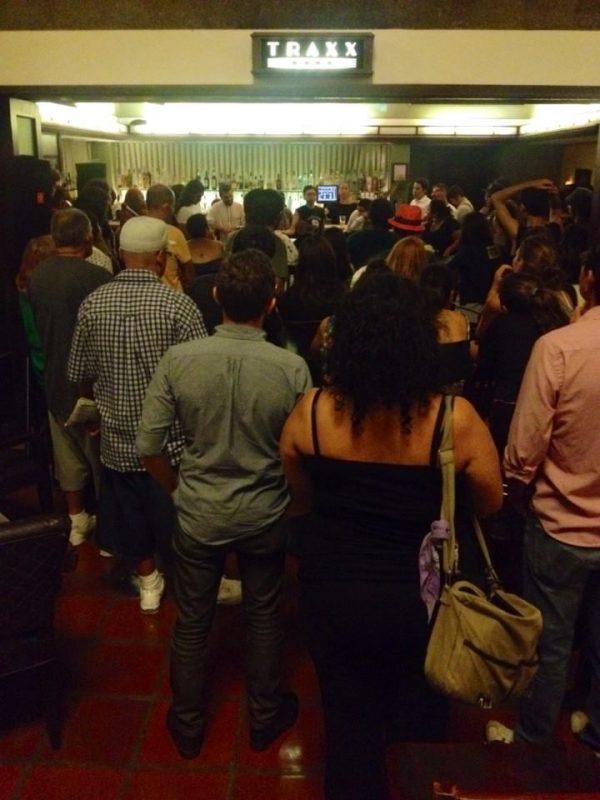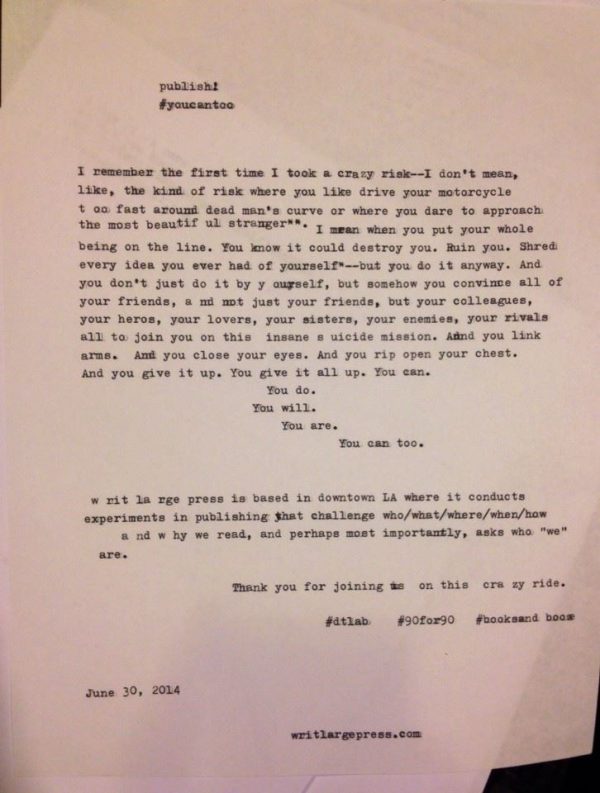In the spring of 2014, I was preparing to head off to (another) graduate school, leaving LA, my home for the last decade, behind along with my friends, job, collaborators, family and even my husband. Chiwan’s mom, my mom-in-law, was in and out of the hospital with a prognosis that went from bad to worse to “it’s experimental” to cured! Emotionally we were all over the place, celebrating one moment and scared shitless the next. So it was not surprising, actually quite par for the course, that we responded to all that emotional turmoil with “Let’s do another project!”—art avoidance, art of avoidance, avoidance as art. I’m sure there are other more evolved ways to deal, but art happens to be the way that we know, the hammer in our tool belt we use to swing away at our problems. It’s what calls us to community, binding together our experiences, bearing witness to all the messiness of getting through this life.
So Peter Woods swung into action, finding a local business owner who wanted to partner with us, a restaurant/bar who would benefit from the buzz of constant events, and thus the wild idea of hosting a whole summer’s worth of literary and cultural programming, one event every night, was born.
I cut out halfway through the 90 events for grad school on the other side of the country. But I think I saw and heard enough to recount some of the lessons learned from the first 90X90 and the way those lessons, and the research I’ve done since, is influencing how we’re tackling the next 90X90.
[alert type=alert-white ]Please consider making a tax-deductible donation now so we can keep publishing strong creative voices.[/alert]
Lesson 1: Partnering is Hard

It was with the wild idea in mind, that books are not a dying industry, a good cause in need of rescuing, but a vital and valuable part of any community, that we set out to partner with a local business to host 90X90. We thought that filling seats in their restaurant/bar with a steady stream of LA creatives would not just bolster sales, but create loyal customers, happy to find a business that recognized them as more than a drink order. In exchange for this service, we tried to negotiate a small cut of the bar. That way we could fund the project without having to charge a cover that would undoubtably prevent many from attending.
Our original partnership was with Kitchen Table, a bar/restaurant who wanted to treat 90X90 as a pop-up. The arrangement made sense for them, but then the owner failed to get all of the pieces together to actually open. The next option was a last minute forced marriage arranged by through the Downtown LA neighborhood council, the councilman’s office, the LA Cowboy, and various others. It was never really what is or the restaurant wanted, and when we were kicked out about two weeks in, without skipping a beat, a third location, Traxx Bar in Union Station, reached out through Facebook and offered to host us. We were grateful and we stayed at Traxx for the rest of the 90 days.

Writ Large Press runs lean without any outside funding because it allows us two freedoms: 1) to try out wild ideas both large and small; and 2) to respond to our community in ways that are meaningful for us as a company, as artists and as good neighbors and citizens. Know this is possible: without funding, with an actual zero dollar budget, through negotiations between neighbors and businesses, we put on 90 well-attended events and the organizers walked away with a few dollars in their pocket (not that that will compensate for the hours and hours of work that went into it). But money is a tricky thing, and the cultural difference between bar owners and a scrappy literary press cannot be overstated. None of these relationships ran smoothly. Never were the expectations totally clear. I mean, I can’t blame them. We didn’t know what 90 events in 90 days would look like, so how could we possibly expect a local restaurant to know. While in our heart of hearts we believe that literature has an important part to play in local communities and economies, we wish we had formed a broader coalition of interested and invested neighbors and artists to make the partnerships more sustainable.
Lesson 2: Holding Space
Really, this is the fun part—curating readings and music, hosting neighborhood discussions and panels. Through curating the events, we came to understand our role in organizing not just the events, but the culture and values of the space itself. As we got better and better at articulating those values, we were surprised to see how willing most everyone was to adopt them. For example, it was important that we feature events from a diversity of experiences, across socio-econonic, cultural, ethnic and geographic lines (geography is everything in LA). So when someone would call us up and propose an event, Chiwan found himself saying, “That sounds great, but it can’t feature all white people,” and white event hosts agreed and put in the extra effort to reach beyond their immediate circles.
Over time, we also became exhausted, and sometimes found ourselves slacking off, failing to maintain the on-site culture or put in the extra work to help each presenter create an event that aligned with the values of the event. In one case, we hosted a discussion on “art spaces” that turned into young white artists whining that they couldn’t turn LA’s Eastside into their own personal playground. We were like, “Shit, that can’t be the final word on the issue.” So, Jessica Ceballos quickly contacted NELA Alliance and co-organized an event on gentrification in North East LA. It turned out to be one of the best-attended and most moving events of the summer.

Lesson 3: Extending Ourselves
The defining aspect of 90X90, the oh-my-god-90-events!, is also the most important. Putting on so many events in such a short period of time forced us to reach way beyond the “usual suspects” of artists we love and trust. Each time we worked with a new group of artists, we built a new relationship. Several new relationships, really: between us and the artists and the audiences. It pushed us to create new events, make wackier connections and encourage interdisciplinary collaborations. We (by we, I’m referring now to all of the participants, not just WLP) found ways for the skateboarders who hung at the edge of the crowd to present their poems, and visual artists to project on the ceiling, and performance artists and jazz musicians to forge collaborations. Each time an artist or group performed, who “we” were changed. Each time an artist performed, the space itself was changed. Each time an artist performed, what this was, this “90X90,” changed, evolved, breathed. Our regular event-goers bore witness to that, and it was an experience that is unparalleled in our event-going lives.

Resistance is Lit in 2017
I’m now working on my third year of a PhD program in Human Computer Interaction at Carnegie Mellon. Part of my research has been on how social justice activists use tools like Twitter and the way their campaigns emerge and are shaped by the mass participation possible through online tools. When I hear the activists talk about a successful campaign engaging multitudes, I think about that feeling in the train station in 2014, when each artist shaped who and what and where we were becoming simply by sharing their words. I think about how Woke Baby and Janet Mock and Shepard Fairey all shape this moment, this movement, without needing to be exactly aligned by identity, issues, politics or tactic.
We’ve put a lot of thought into how we can use some of what we’ve learned from other activists in organizing 90X90 and encouraging it to grow by using social media and other online tools.
We are using this Google form to help us organize, collect resources, build those coalitions and reach new folks. We hope to figure out a structure that helps distribute the work of organizing while building wider participation and giving more voices the chance to be heard. If you’re interested in participating in 90X90 in any way, please fill out the form.
We’ve put thought into how 90X90 might have a life outside of LA and beyond 2017. We hope that folks in other cities will consider organizing similar series of events. We want to open new relationships with other organizers, artists and communities.
One of the problems we came across is if we want events to happen in multiple places, and we want them to use social media to share the work, then we also need to figure out good hashtags. We decided to use two hashtags: #90X90LA and #ResistanceIsLit. #90X90LA refers to the events being organized in LA. This hashtag could be potentially modified for other cities (e.g. #30X30OKC). #ResistanceIsLit is a hashtag that could be used across cities and encapsulates how we see these events as a form of literary resistance. Together the two hashtags communicate the larger idea and could be used to announce city-specifc events. The solution isn’t perfect, but it’s the best that we have right now.
Another issue to address is how to share the performances online. Sharing the performances online will potentially create a digital space with some of the properties of the physical space, and will make it possible to build relationships with artists in other cities. While it’s easy enough to live stream everything, who wants to watch a gazillion hours of live streamed readings? There must be ways to index and present these videos, but it’s a problem we have yet to tackle.
We are also taking the time to run to articulate our experiences with 90X90 and our vision for its future through blogs like this. To that end, we are inviting a range of participants from 90X90 2014 to share their perspectives and help us collectively define and develop #ResistanceIsLit. Look for these posts in the weeks to come.
We are not one thing, but whatever we are, will come into being through our words.
